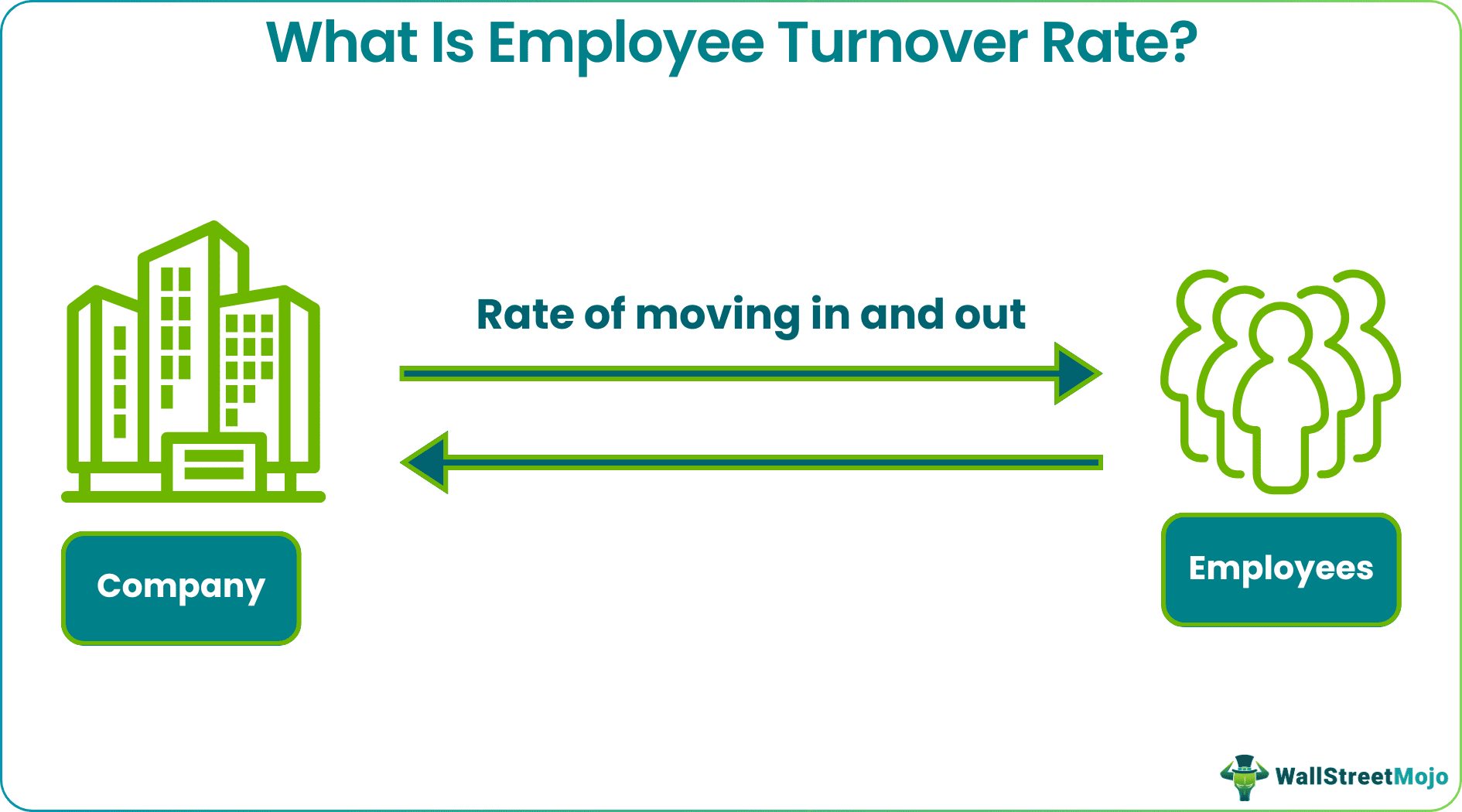Table Of Contents
Turnover Rate Meaning
The turnover rate in an economy-wide aspect is referred to as the sum of net employment changes. It is calculated as a percentage of total employment across all firms and establishments. Anyone who departs for any reason is included in the rate. Resignations, retirements, and terminations fall under this category.

Employee turnover varies by industry. The reasons, among others, include a lack of remote work possibilities, a lack of opportunities for career advancement, burnout, toxic corporate cultures, and changing careers to follow other interests. As a result, unemployment spikes can have a negative impact on a person's life as well as the economy.
Key Takeaways
- The turnover rate is the movement of employees in and out of an organization. It indicates the total number of employees quitting (voluntarily or involuntarily) within a given period.
- The two primary types of turnover are voluntary and involuntary. Voluntary turnover occurs when employees choose to leave the organization.
- Involuntary turnover occurs when employees are fired and don't choose to leave an organization.
- Any form of unemployment stresses the individual's finances, not to mention the adverse effects on physical and mental health.
- However, in certain ways, the rising turnover rates signify a healthy labor market. Meaning there are several employment options available to workers.
Turnover Rate Explained
The turnover rate is the aggregate number of employees quitting (voluntary or involuntary) within a specific time. On the other hand, "employee turnover" refers to employees quitting their jobs or leaving the organization they work. Estimations of turnover typically consider voluntary resignations, non-certifications, employees being fired, and retirements. Internal transfers and promotions are usually excluded from them. Employee turnover rate indicates how well a business and its human resources management system are managed.
The two primary types of turnover are voluntary and involuntary.
- Voluntary turnover happens when workers leave organizations or institutions on their initiative and not the employers. Employees may do this for various reasons, including job dissatisfaction, disengagement, conflict at work, better job opportunities elsewhere, better pay, and more. Resigning, retiring, transferring to another business or organization, moving, or taking spouses on vacation are just a few examples of the same.
- In contrast, involuntary turnover occurs when employees don't choose to leave an organization. In other words, involuntary turnover occurs when workers lose jobs for failing to meet performance standards, engaging in toxic behavior, being absent from work, violating company rules, or other reasons.
Any form of unemployment stresses the individual's finances, not to mention the adverse effects on physical and mental health. However, in certain ways, the rising turnover rates are a sign of a healthy labor market. Meaning there are several employment options available to workers. This implies that smart individuals ought to be able to secure a position in a company they enjoy at a competitive salary.
Additionally, it implies that employees have options if the business is not a good fit and can shift effortlessly, indicating the economy is doing well. When the economy is growing, and many new, better opportunities arise, people make such shifts in such an economy.
Factors That Contribute To The Turnover Rate
There may be various factors affecting turnovers, and they are as follows:
- Absence of opportunities for development or career advancement.
- Poor management from the company's side.
- A natural progression of one's career, where a shift is inevitable.
- Lack of the necessary resources, assistance, or training to perform their duties properly.
- Internal transfer or promotion.
- Experiencing stress, exhaustion, or burnout.
- Negative attitude towards management or the boss.
- Toxic working conditions.
- Family or personal event; a competitive offer (pay and other benefits).
- Recently, the desire for remote work has made people quit work from office jobs.
- In involuntary turnover, not following company policies, absenteeism, underperformance, or other undesirable action can cause termination.
Formula
Employee turnover rates vary by company, region, and industry. The BLS (Bureau of Labor Statistics) computes the average turnover rate by industry and other metrics for every nation, state, and market segment.
The following formula does the calculation of the annual total separation rate by the U.S. BLS:
Total separations rate = annual average number of employees/no of employee departures*100.
Note: separations rate (annual) is the total number of separations during the entire year expressed as a percent of an annual average employment.
Calculation Example
The U.S. has 158.47 million employed people among its population (2023) and has 5.7 million separations in the year. The calculation of turnover rate for the year will be calculated as follows:
Total employment= 158.47 million (approximately)
Total separations 5.7 million
Applying the formula Total separations rate = annual average number of employees/no of employee departures*100.
We get,
158.47 /5.7 *100=27.8 %
This means the U.S. annual total separations rate in 2022 is 27.8 percent.
Turnover Rate vs Attrition Rate vs Retention Rate
| Key points | Turnover Rate | Attrition Rate | retention rate |
|---|---|---|---|
| Essence | Measures the movement of the workforce and includes new hires. | Attrition happens when an employee quits on their initiative, and the company decides not to fill their position. | Measures workforce stability but excludes new hires. |
| Inclusion criteria | Turnover includes both voluntary and involuntary rates. | Attrition is mostly concerned with involuntary turnover. | It may exclude involuntary turnover, especially those seasonally laid off. |
| Period of calculation | It is usually calculated monthly. | Retention is typically calculated on an annual basis. | Attrition is calculated over some time, preferably yearly. |

